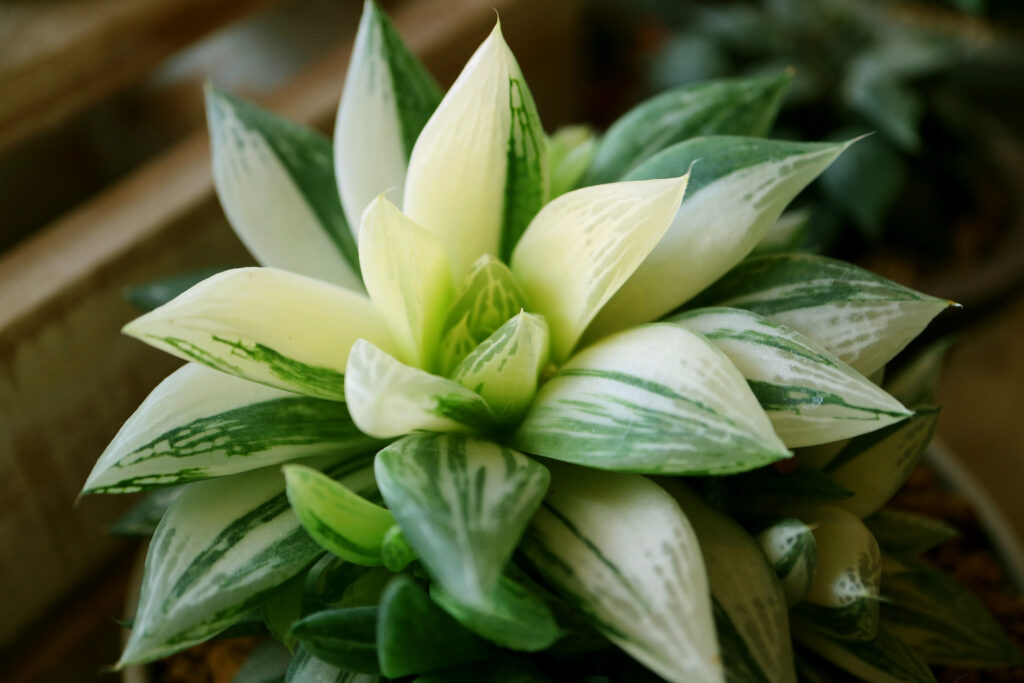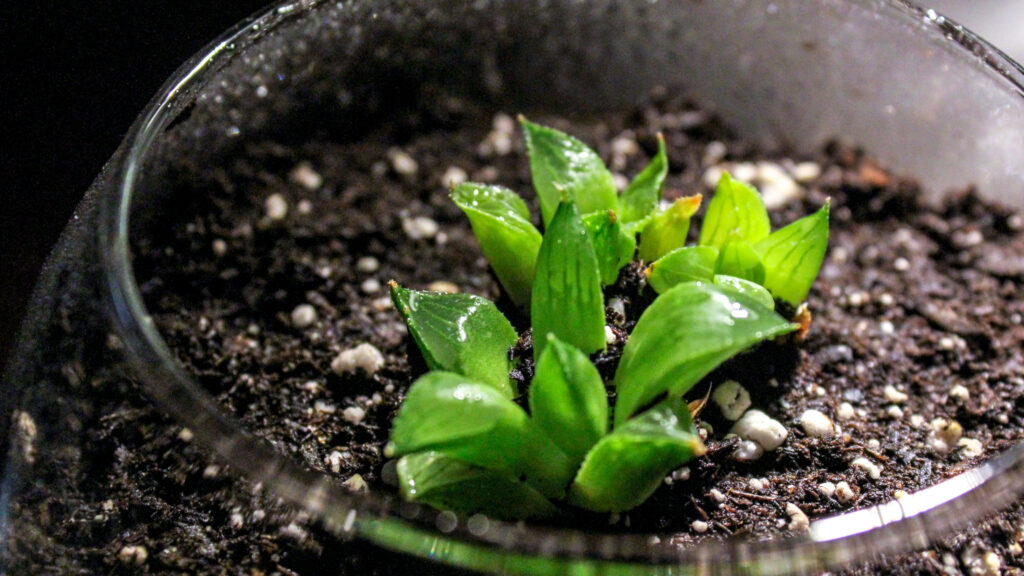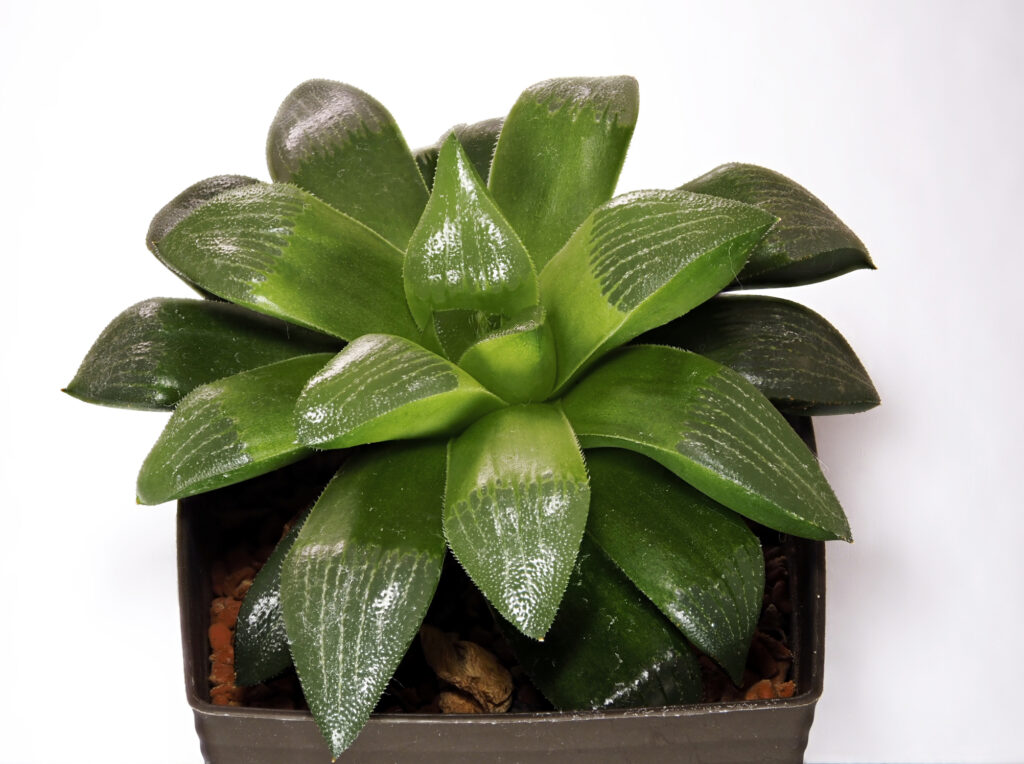Haworthia Retusa Care: Tips on Growing & Caring for the Star Cactus Haworthia
Petite succulents are perfect for decking out indoor spaces. And there's no way to bring in some vibrant color to your role desk or windowsill than growing the Haworthia Retusa succulent. If y'all're looking to add together some greenery and purify the surrounding air, and then your hunt for the right houseplant could be over after reading this guide.
Same equally Haworthia cooperi, this miniature delicious belongs to the Asphodelaceae family unit, and it's a variegated species that doesn't demand besides much routine nurturing or maintenance. No matter how tiny or slow-growing it tin be, this perennial succulent tin survive for years when grown nether the right conditions.

Star Cactus Haworthia at a Glance
The Star cactus Haworthia is a gripping succulent with a compact set of rosettes fabricated of paunchy and dense-greenish leaves. One signature feature on the texture of the leaves is a layer of whitish warts that brand this variety have an outlandish look.
And same as other succulents nosotros've had a chance to review, this Haworthia blazon can't get enough of bright light, tolerable moisture during summertime, and moderately dry weather condition when the temperatures are freezing. To get a snapshot of its groundwork, the perennial succulent is native to Riversdale—a semi-arid region on the Western Cape province in South Africa.
Don't be troubled to observe information technology labeled every bit the 'Star cactus,' 'Aloe retusa', or 'Window Succulent' in your nearest gardening store or nursery. With the correct growing requirements, this delicious can blossom while sitting on a windowsill or outdoors in the garden alongside other cacti plants.
As a tedious-growing succulent, the most information technology'll attain is a set of rosettes with triangular-shaped leaves. It hardly grows beyond 5" inches tall. The leaves are made of a translucent tissue that has no stomata to prevent them from losing water, this retaining wet when exposed to intense estrus.
Arguably, this kind of indestructible nature is rare to find on other ordinarily cultivated houseplants. Keep reading to get a concord of the growing and caring tips y'all'd need to work with, to brand your Star cactus have the utmost longevity it deserves.
How to Abound the Star Cactus

You can choose to abound this succulent using leafage cuttings or offsets that autumn off from the female parent plant and grow on the edges of the container. I tend to find using offsets a lot easier since they can be pulled out when transplanting. To acquit out the exercise, you'll need to:
- Carefully remove the mother plant and transplant it into a bigger container.
- Moisten the soil to avert damaging the offsets when uprooting them.
- If you're looking to utilise leaf cuttings, use a sterilized pocketknife to prevent the mother plant from catching infectious diseases.
- Use leaf cuttings that appear to have no marks or signs of rotting. Make the cutting right below the stem.
- Before planting the offsets, leave them to dry overnight.
- You might need to use rooting hormone on the foliage cuttings.
- Set the potting soil using tips right under the soil and transplanting section in this guide.
- Place the growing medium somewhere with bright indirect low-cal.
- While the baby offsets and foliage cuttings will need to be watered regularly, you want to allow some grace period for the soil to dry out between the watering intervals.
Haworthia Retusa Caring Tips

Flowering & Fragrance
During the blooming season, yous might be lucky to see a tall flower stalk developing right from the middle of the rosette. These tiny whish flowers will appear in a tubular shape during tardily spring or the early weeks of summer.
Since about Haworthia varieties tend to be slow-growing, don't wait the flowers to await wondrous all through the blooming season. If your Star Cactus yields any flowers, that suggests it's in a perfect health condition and the soil has enough phosphorus to back up the flower formation process.
Soil & Transplanting
It's best to utilise a cactus mix or set up a potting mix that supports fast drainage. This delicious also prefers a soil pH betwixt vi.5 to 7.v. Some gardeners argue that amending the potting soil with sand blocks the pores that let water drain much quicker. And so, you might consider using pumice or perlite instead of sand. Other additives you lot might consider working with to balance the pH and heave the number of nutrients include bonemeal and limestone.
Bonemeal adds phosphate to the soil, which promotes the development of roots, while limestone feeds your Star cactus with magnesium and calcium. Since most Haworthia varieties are petite plants, you lot can grow a agglomeration of them in a container to increase the rate at which they purify the air. Use 2 ounces of both limestone and bonemeal for every 4 gallons of water, and utilise the solution during the normal watering schedule.
I adopt to sterilize my garden soil before planting past heating it in the oven at xc degrees Celsius. And due to their size and speed, which they sprout at, in that location won't be whatever great demand for transplanting. But if y'all're looking to replace the erstwhile soil with 1 that'due south revitalized with nutrients, it's best to transplant your Aloe retusa during tardily spring or the early on weeks of summertime when the growth hormones are in full swing.
Some offsets will fall off from the mother plant and abound on the edges of the container, so you'll need to remove them while transplanting since they make the best option if you're looking to propagate your Aloe retusa houseplant. You'll typically need to transplant it every 2-4 years.
Watering & Feeding
Y'all might miss seeing your Haworthia abound opulently by using the wrong watering formula. With all the succulent traits ingrained on this perennial, you don't expect it to gulp so much h2o quite regularly. Newbie gardeners might be tempted to water this houseplant so often so they can see it sprout much faster.
Avoid keeping the soil soggy for longer hours since the roots will begin to rot. Yous'll, therefore, need to wait for the soil to dry entirely earlier watering your Aloe retusa again. Frequent watering is only needful during summer when the temperatures are high, just you'll need to cut back on the intervals when it's winter. Don't expose the rosette to any moisture since it'll ultimately start to decay.
The stems also are susceptible to rotting when the soil remains wet for too long, especially during winter. Since the Aloe retusa plant carries succulent traits, we recommend using cactus fertilizer that's soluble in one case every three weeks during summertime. Follow the tips on the label of the fertilizer and avoid feeding your Haworthia succulent when it's wintertime.
Light & Temperature
Information technology's the norm for succulents to prefer warmer environments. Your Star cactus volition prefer USDA hardiness zones 9 to 11, where there are barren weather condition similar to those of Southward Africa where it'southward native to. For any other region, the Star cactus is ordinarily grown as an indoor plant. And it's no wonder why this perennial is mostly grown across the due west coast and southern states of the US.
Fifty-fifty though information technology prefers warm conditions, it likewise thrives under cold weather during wintertime. You lot'd be surprised to see it survive under temperatures as low as 10 degrees Celsius. While it opts for bright light, make certain to filter the intense rays from the dominicus. If it'south growing outdoors, you want to limit the number of hours it sits in the sun by placing the medium under some partial shade.
When growing in their native surround, they're fond of seeking shade beside rocks, trees alongside other objects. For a Star cactus growing indoors, placing information technology on a windowsill facing east or due west would be platonic since it would get enough bright light for just a few hours. If the leaves begin to have some whitish or yellow patches, that could be a sign your Haworthia is getting scorched past the sun.
On the other side, if you don't betrayal it to enough bright low-cal, the dumbo-dark-green colour on the foliage will somewhen begin to fade off, and the leaves volition lose their vigor. As the warm season begins to clock in, innovate your Star cactus to the dominicus gradually, so the estrus waves don't burn the leaves. It's piece of cake to bring it outdoors during summer when grown in a container. For optimal growth, you desire to keep the room temperature anywhere between 21-32 degrees Celsius.
Grooming & Maintenance
Yous don't need to go along a tight grooming routine for this succulent; it doesn't need ane. For the well-nigh part, you'll only need to get rid of the expressionless petals once the blooming season is over. Await out for whatsoever parts of the institute that seem to prove signs of rotting.
Dissect the affected area to avoid losing the entire found. If there are then many offsets on the base of operations of the mother plant, they'll begin to compete for nutrients, then you lot'll need to control the number and use some for propagation.
Mutual Pests & Diseases
Most succulents growing in areas with cool temperatures only humidity are highly likely to be infested with fungi. The stems are usually the most affected areas, followed past the leaves. One of the early on signs to lookout man out for is black spots forming on the leaves. Overwatering is yet another condition your succulent volition tussle with that ultimately causes the leaves to plough yellow. One handy tip to keep this from happening is to wait till the soil dries up completely before watering your Star Cactus again.
colontexprolven1979.blogspot.com
Source: https://www.diys.com/star-cactus/
0 Response to "Haworthia Retusa Care: Tips on Growing & Caring for the Star Cactus Haworthia"
Post a Comment